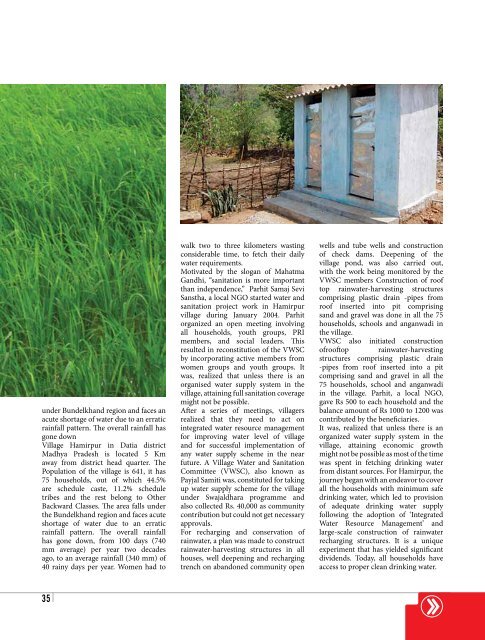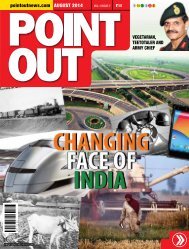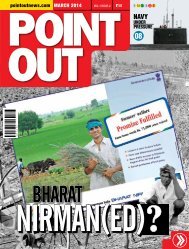pointoutnews.com march 2015 A bridge between India and Bharat
You also want an ePaper? Increase the reach of your titles
YUMPU automatically turns print PDFs into web optimized ePapers that Google loves.
under Bundelkh<strong>and</strong> region <strong>and</strong> faces an<br />
acute shortage of water due to an erratic<br />
rainfall pattern. The overall rainfall has<br />
gone down<br />
Village Hamirpur in Datia district<br />
Madhya Pradesh is located 5 Km<br />
away from district head quarter. The<br />
Population of the village is 641, it has<br />
75 households, out of which 44.5%<br />
are schedule caste, 11.2% schedule<br />
tribes <strong>and</strong> the rest belong to Other<br />
Backward Classes. The area falls under<br />
the Bundelkh<strong>and</strong> region <strong>and</strong> faces acute<br />
shortage of water due to an erratic<br />
rainfall pattern. The overall rainfall<br />
has gone down, from 100 days (740<br />
mm average) per year two decades<br />
ago, to an average rainfall (340 mm) of<br />
40 rainy days per year. Women had to<br />
walk two to three kilometers wasting<br />
considerable time, to fetch their daily<br />
water requirements.<br />
Motivated by the slogan of Mahatma<br />
G<strong>and</strong>hi, “sanitation is more important<br />
than independence,” Parhit Samaj Sevi<br />
Sanstha, a local NGO started water <strong>and</strong><br />
sanitation project work in Hamirpur<br />
village during January 2004. Parhit<br />
organized an open meeting involving<br />
all households, youth groups, PRI<br />
members, <strong>and</strong> social leaders. This<br />
resulted in reconstitution of the VWSC<br />
by incorporating active members from<br />
women groups <strong>and</strong> youth groups. It<br />
was, realized that unless there is an<br />
organised water supply system in the<br />
village, attaining full sanitation coverage<br />
might not be possible.<br />
After a series of meetings, villagers<br />
realized that they need to act on<br />
integrated water resource management<br />
for improving water level of village<br />
<strong>and</strong> for successful implementation of<br />
any water supply scheme in the near<br />
future. A Village Water <strong>and</strong> Sanitation<br />
Committee (VWSC), also known as<br />
Payjal Samiti was, constituted for taking<br />
up water supply scheme for the village<br />
under Swajaldhara programme <strong>and</strong><br />
also collected Rs. 40,000 as <strong>com</strong>munity<br />
contribution but could not get necessary<br />
approvals.<br />
For recharging <strong>and</strong> conservation of<br />
rainwater, a plan was made to construct<br />
rainwater-harvesting structures in all<br />
houses, well deepening <strong>and</strong> recharging<br />
trench on ab<strong>and</strong>oned <strong>com</strong>munity open<br />
wells <strong>and</strong> tube wells <strong>and</strong> construction<br />
of check dams. Deepening of the<br />
village pond, was also carried out,<br />
with the work being monitored by the<br />
VWSC members Construction of roof<br />
top rainwater-harvesting structures<br />
<strong>com</strong>prising plastic drain -pipes from<br />
roof inserted into pit <strong>com</strong>prising<br />
s<strong>and</strong> <strong>and</strong> gravel was done in all the 75<br />
households, schools <strong>and</strong> anganwadi in<br />
the village.<br />
VWSC also initiated construction<br />
ofrooftop rainwater-harvesting<br />
structures <strong>com</strong>prising plastic drain<br />
-pipes from roof inserted into a pit<br />
<strong>com</strong>prising s<strong>and</strong> <strong>and</strong> gravel in all the<br />
75 households, school <strong>and</strong> anganwadi<br />
in the village. Parhit, a local NGO,<br />
gave Rs 500 to each household <strong>and</strong> the<br />
balance amount of Rs 1000 to 1200 was<br />
contributed by the beneficiaries.<br />
It was, realized that unless there is an<br />
organized water supply system in the<br />
village, attaining economic growth<br />
might not be possible as most of the time<br />
was spent in fetching drinking water<br />
from distant sources. For Hamirpur, the<br />
journey began with an endeavor to cover<br />
all the households with minimum safe<br />
drinking water, which led to provision<br />
of adequate drinking water supply<br />
following the adoption of ‘Integrated<br />
Water Resource Management’ <strong>and</strong><br />
large-scale construction of rainwater<br />
recharging structures. It is a unique<br />
experiment that has yielded significant<br />
dividends. Today, all households have<br />
access to proper clean drinking water.<br />
35
















